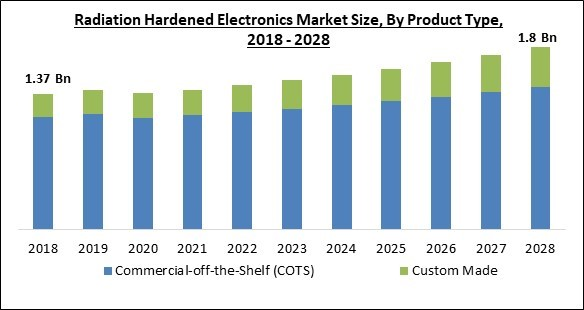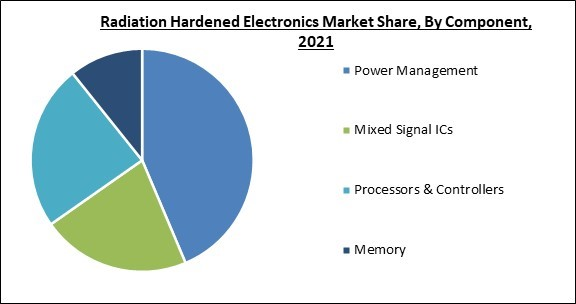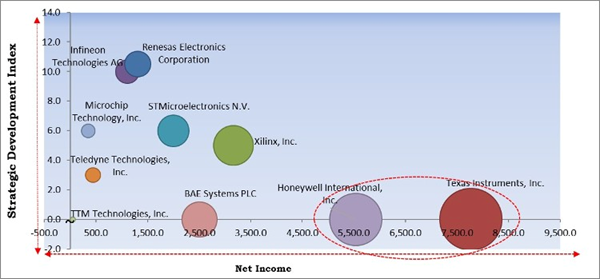Radiation hardening entails extensive radiation survival testing, sometimes referred to as radiation effects checking. Radiation survival testing involves irradiating materials to see how long they can tolerate the harsh extremes of operational environment and, ultimately, which material is best for a given radiation-hardened component. Since the high radiation within the reactor produces adequate neutron yield for the tests, the majority of radiation survival testing is done in nuclear reactor facilities. However, employing reactors has limitations, such as a big footprint and extensive regulatory burden due to the presence of highly enriched uranium and nuclear waste production.
Electronic components such as circuits, resistors, transistors, diodes, capacitors, and many more, single-board computer CPUs, and sensors that are designed and manufactured to be less susceptible to damage from radiation and extreme temperatures (-55°C to 125°C) are known as radiation-hardened electronics or rad-hard electronics.
They essentially perform the same activities as non-hardened equivalent electronics, but they've been designed and tested to withstand various sorts of radiation possible damage in space, during high-altitude flights, at scientific research centers, and in nuclear reactors. Rad-hard electronics are additionally insulated in a layer of depletion boron and installed on insulating substrates rather than typical semiconductor wafers as part of the 'hardening' process.
They can withstand significantly more radiation than commonly produced semiconductors because of this. All of these measures are focused on minimizing both logical and physical harm, such as data loss, communications and processing problems, and device failure. Rad-hard electronics are frequently used by space programs, private spaceflight companies, the defense community, and research scientists to ensure reliable and consistent performance and longer service life in cruel radioactive and similarly dangerous environments due to extremely low system failures across several years in cruel radioactive and similarly dangerous environment.
COVID-19 Impact Analysis
COVID-19 has had a considerable impact on the value chain and the desire for radiation-hardened electronics in a variety of applications. COVID-19 has a considerable impact on satellite manufacturing through the use of radiation-hardened electronic components. Low production quantities and a high level of expertise characterize this sector, which has a small number of suppliers. COVID-19 has also caused supply chain disruptions, longer lead times in raw resources and components supplies, delays in contract executions, and lockdowns in several nations, particularly in Europe, where the third phase of lockdown was implemented in the first quarter of 2021. Some of the industry's manufacturing activities are also delegated to back-end subcontractors and external silicon foundries.Market Growth Factors
Utilization of radiation-hardened electronics in commercial satellites
The demand for small satellites is increasing as the demand for affordable satellite communication for diverse purposes including agriculture monitoring, television programming content and mobile phone connection, and military surveillance and monitoring grows. Commercial satellites are frequently launched in geosynchronous orbits for maximum coverage and with a lifespan of 15-20-year. The requirement for radiation-hardened electronics systems has increased as the number of communication satellites in earth's orbit has grown. OneWeb, SpaceX, Amazon, and Telesat are among the New Space entrepreneurs intending to launch a giant constellation of thousands of low-earth-orbit satellites in the coming years to improve the connection network.Increasing the use of space missions in space stations
The demand for better radiation-hardened components, innovative configuration, design methodologies, and software models to enhance the radiation endurance of electronic components is increasing as the number of space missions increases. The United States was the first country to collaborate closely with a number of space organizations and express an interest in pursuing space-related initiatives. Its production and testing capabilities, as well as skilled workers, make it a lot easier for the nation to carry out these tasks. The country is very interested in growing its commercial spacecraft sector and promoting space tourism. NASA and SpaceX launched its Crew-4 mission in April 2022 with an all-citizen crew to conduct microgravity research aboard the space station and expand access to space for more people.Market Restraining Factors
Multiple Harsh Environments Radiation-Hardened Circuits
Semiconductor electronic devices and circuits are frequently exposed to hard environments where they may be exposed to ionizing radiation settings, and as a result, the circuits may fail and the overall modules of the system may collapse, necessitating the use of RADHARD circuits. RADHARD circuits are typically found in nuclear reactors, space application circuit modules, and device internal modules where the circuits must operate without interruption due to ionizing radiation effects. RADHARD is a method of designing an electronic circuit such that it will work without fail in ionizing radiation-affected locations. Even if there is any form of ionization effects present. To create these circuits since there is a high demand for them to perform precisely and efficiently in the modules that develop, particularly in Crewed Spacecraft, Army Aircrafts, Satellite, Nuclear Power Plants, and Nuclear Power Weapons, among other things.Component Outlook
Based on Deployment, the market is segmented into On-premise and Cloud. The cloud segment garnered a substantial revenue share in the Radiation Hardened Electronics Market in 2021. The expanding use of learning analytics, lower cost of ownership, and increased acceptance of mobile learning in the EdTech sector can all be related to the larger share. Cloud deployment is appealing to businesses of all sizes because it provides regular data backup, reducing operating costs, less capital, highly secure, and quick deployment characteristics for always-on operation.Type Outlook
Based on Component, the market is segmented into Power Management, Mixed Signal ICs, Processors & Controllers, and Memory. The mixed signal ICs segment recorded a substantial revenue share in the Radiation Hardened Electronic Market in 2021. Due to the demand for more complicated analog and mixed-signal radiation-resistant (RH) integrated circuits is being driven by the rise of the satellite business and new defense/aerospace technology. Many of the digital needs can be met using RH FPGAs and microprocessors, but analog must rely on COTS RH components or design a unique solution (RH analog custom ASIC).Manufacturing Technique Outlook
Based on Manufacturing Technique, the market is segmented into Radiation-Hardening by Design (RHBD) and Radiation-Hardening by Process (RHBP). The Radiation-Hardening by Design (RHBD) segment procured the largest revenue share in Radiation Hardened Electronic Market in 2021. Cue to the low cost, simplicity of customization, and capacity to mass-produce radiation-hardened devices are all factors contributing to the segment's rise. RHBD makes use of a variety of principles, including layout solutions and element configuration. This manufacturing approach allows circuit operation to be reconfigured to avoid cells failing during the operation and improves dependability in severe situations.Product Type Outlook
Based on Product Type, the market is segmented into Commercial-off-the-Shelf (COTS) and Custom Made. The custom made segment registered a significant revenue share in the Radiation Hardened Electronic Market in 2021. It is due to the corporations are embracing a number of advances, which necessitates a massive amount of effort, money, time and R&D. In addition, manufacturers must adapt design techniques based on the end user's specific requirements, resulting in lengthy radiation-hardened component development cycles.Application Outlook
Based on Application, the market is segmented into Space, Aerospace & Defense, Nuclear Power Plant, Medical, and Others. The space segment garnered the largest revenue share in the Radiation Hardened Electronic Market in 2021. Due to the increased ISR operations, as well as a growth in the number of space missions, are pressuring radiation-hardened electronics manufacturers to develop more robust and reliable electrical parts for space applications. As of April 2020, around 2,666 functioning satellites are orbiting around the planet, according to The Union of Concerned Scientists (UCS).Regional Outlook
Based on Regions, the market is segmented into North America, Europe, Asia Pacific, and Latin America, Middle East & Africa. The North America segment procured the largest revenue share in the Radiation Hardened Electronic Market in 2021. The leading companies such as Honeywell Aerospace & Defense (US), Microchip Technology (US), and Xilinx, Inc. (US), leading space research institutes such as the U.S. Space Research Institute (FSRI), Keck Institute for Space Studies (US), and National Aeronautics and Space (NASA) have contributed to the industry's growth (KISS). In several countries, the United States provides most radiation-hardened equipment.Cardinal Matrix-Radiation Hardened Electronics Market Competition Analysis
The major strategies followed by the market participants are Product Launches. Based on the Analysis presented in the Cardinal matrix; Texas Instruments, Inc. and Honeywell International, Inc. are the forerunners in the Radiation Hardened Electronics Market. Companies such as Renesas Electronics Corporation, STMicroelectronics N.V., Infineon Technologies AG are some of the key innovators in the Market.
The market research report covers the analysis of key stake holders of the market. Key companies profiled in the report include Renesas Electronics Corporation, STMicroelectronics N.V., Infineon Technologies AG, Texas Instruments, Inc., Microchip Technology, Inc., Teledyne Technologies, Inc., Honeywell International, Inc., BAE Systems PLC, Xilinx, Inc., and TTM Technologies, Inc.
Strategies Deployed in Radiation Hardened Electronics Market
Product Launches and Product Expansions:
- Apr-2022: Infineon Technologies unveiled radiation-hardened, serial interface Ferroelectric RAM for the harsh ecosystem. The rad-hard F-RAM devices offer premium abilities with less power necessities than substitute, and support system designs with lesser parts, enhanced version, and no settlement in dependability.
- Mar-2022: Teledyne e2v HiRel launched TD99102 UltraCMOS, a High-speed FET and GaN transistor driver delivering a very high changing speed of 20 MHz. The new TD99102 UltraCMOS quick edge paces and radiation patience make them perfect for the latest MEO and LEO constellations where performance is key.
- Mar-2022: ST Microelectronics introduced LEO Rad-Hard IC, a series of radiation-hardened power. The LEO Rad-Hard IC with plastic packages for engineers to develop small, low-cost satellites in low Earth orbit. Additionally, the series is expected to deliver a low-voltage differential signaling transceiver, onboard computers, a tube driver and five logic gates used in power era and allocation, a voltage controller, and telemetry star trackers and transceivers.
- Jul-2021: Infineon Technologies launched QML-V flow, the industry’s first high-density radiation-tolerant. The QML-V flow is the highest quality and dependability benchmark certification for aerospace-grade ICs. Additionally, radiation-tolerant dual QSPI non-volatile recollections are completely supported by the advanced space-grade FPGAs. They allow a premium, less pin count, single-chip choice key to configure procedure and FPGAs.
- Jul-2021: Renesas Electronics Corporation unveiled a new range of plastic-packaged radiation-hardened devices for satellite power management systems. The new range of devices provides the ISL73033SLHM 100V GaN FET, ISL71001SLHM/SEHM point of load (POL) buck regulator, integrated low-side driver, and ISL71610SLHM and ISL71710SLHM digital isolators.
- Apr-2021: Microchip Technology introduced the qualification of its SAMRH71 Arm-based microprocessor (MPU) and launched of the SAMRH707 microcontroller (MCU), by deploying ArmÒ CortexÒ-M7 SoC radiation-hardened technology. To allow system designers with better integration and enhanced performance along with decreasing development costs and time to market, COTS technologies and scalable solutions are widely utilized in space applications.
- Feb-2021: Microchip Technology expanded its prevailing SA50-120 power converter family by launching nine new units based on its Commercial Off-the-Shelf technology. The SA50-120 family allows developers to begin with proven COTS technology and rapidly climb up evolution, lowering risk and development period.
- May-2020: Xilinx introduced 20nm RT Kintex UltraScale FPGA, the industry’s first 20-nanometer space-grade FPGA. The 20nm RT Kintex UltraScale offers complete radiation resilience and ultra-high throughput and bandwidth performance for satellite and space applications. Additionally, the space-grade FPGA is cracking enterprise measures and forming a new standard for completing the high compute conditions of increased bandwidth loads, space investigation, and investigation missions.
- May-2020: STMicroelectronics unveiled 200V and 400V power rectifiers along with SEB -immune Schottky rectifiers at 45V and 150V. These SEB-rated Schottky devices are convenient to use in various converter topologies. Additionally, SEB -immune Schottky rectifiers of 150V and 45V devices are prepared for immediate contact to 100V and 28V satellite power buses.
Partnerships, Collaborations and Agreements:
- Aug-2021: Xilinx joined hands with STMicroelectronics, a global semiconductor provider serving consumers. Through this collaboration, the companies aimed to construct a power solution for the Xilinx Kintex UltraScale XQRKU060 radiation-tolerant FPGA, utilizing QML-V suitable voltage controllers from ST’s space-products offering.
Acquisition, Joint Venture and Merger:
- Apr-2020: Infineon Technologies completed the acquisition of Cypress Semiconductor Corporation, an American semiconductor design and manufacturing company. Together, the companies aimed to provide an edge for the consumer from the improved global reach and improved design-in support to customized requirements. Additionally, Infineon Technologies deliver as an authorized member for consumers and provider and evolving from a chief in components to a leader in design solutions for the industrial, automotive, and IoT markets.
Geographical Expansions:
- Sep-2021: Infineon Technologies expanded its geographical footprint by establishing a high-tech chip factory for power electronics at its Villach site in Austria. Through this expansion, the companies aimed to establish an enterprise policy milestone in terms of supply protection for both European enterprise and the international market.
Scope of the Study
Market Segments Covered in the Report:
By Component
- Power Management
- Mixed Signal ICs
- Processors & Controllers
- Memory
- Radiation-Hardening by Design (RHBD)
- Radiation-Hardening by Process (RHBP)
- Commercial-off-the-Shelf (COTS)
- Custom Made
- Space
- Aerospace & Defense
- Nuclear Power Plant
- Medical
- Space
- North America
- US
- Canada
- Mexico
- Rest of North America
- Europe
- Germany
- UK
- France
- Russia
- Spain
- Italy
- Rest of Europe
- Asia Pacific
- China
- Japan
- India
- South Kore
- Australia
- Malaysia
- Rest of Asia Pacific
- LAMEA
- Brazil
- Argentina
- UA
- Iran
- South Africa
- Nigeria
- Rest of LAMEA
Key Market Players
List of Companies Profiled in the Report:
- Renesas Electronics Corporation
- STMicroelectronics N.V.
- Infineon Technologies AG
- Texas Instruments, Inc.
- Microchip Technology, Inc.
- Teledyne Technologies, Inc.
- Honeywell International, Inc.
- BAE Systems PLC
- Xilinx, Inc.
- TTM Technologies, Inc.
Unique Offerings from the Publisher
- Exhaustive coverage
- The highest number of Market tables and figures
- Subscription-based model available
- Guaranteed best price
- Assured post sales research support with 10% customization free
Table of Contents
Companies Mentioned
- Renesas Electronics Corporation
- STMicroelectronics N.V.
- Infineon Technologies AG
- Texas Instruments, Inc.
- Microchip Technology, Inc.
- Teledyne Technologies, Inc.
- Honeywell International, Inc.
- BAE Systems PLC
- Xilinx, Inc.
- TTM Technologies, Inc.











